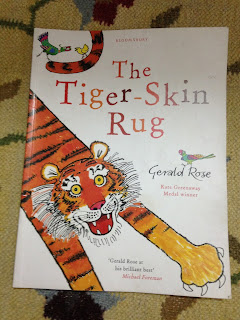My son began pulling out books from the bookshelf just about when he started crawling, and there has been no looking back since. The lowest two shelves of our bookshelf are filled with his books; he reads them as well as many of ours which fill the other shelves (now he can stand on his toes and pull them out!).
2) Cloud Tea Monkeys - written and published in England, set in the tea plantations of East India at a time when Queens and Royal Tea Tasters abounded. Magically illustrated..
3) Library Lion - Set in days when libraries were wondrous places (in India, most aren't any more), this is a lovely way to remind children that sometimes there is a good reason to break rules.
7) The Snowman - A timeless classic, but one that's oft forgotten. Raymond Briggs apparently wanted to convey the essence of life and death through this picture-based story. My son accepts death and the melting away of magical moments in a matter of fact way while reading this book and re-lives the excitement of flying with the snowman at night just before he drops off to sleep ("I can fly...?")
If you need to buy books for children between two and four years of age (though I think we started reading earlier), here are some of our favourites apart from the old classics (which I also mention below) -
Old favourites are- Michael Bond ('Paddington', stories about a bear from darkest Peru, who my son loves to emulate!), A. A. Milne and E. H. Shepard (Winnie-the-Pooh) - we began with all of Pooh's songs (The more it snows/Tiddley Pom/ The more it goes/ Tiddley Pom/ The more it goes/ Tiddley Pom/ On snowing..). Margaret Rey and H. A. Rey (Curious George ("This is Nayan. He lived in Bangalore. He was a good little monkey and always very curious..."). Dr. Seuss (The Cat In The Hat is truly a classic that no child or parent perhaps gets tired of. For younger readers, I recommend Fox in Socks and for the in between ages, Green Eggs And Ham).
My friend Nora introduced us to two authors that Nayan likes enormously- Richard Scarry (What Do People Do All Day) - "Hello tanker, are you lost? No Nayan, I'm just filling some petrol in the underground tank of the petrol pump." Lauren Child (the Charlie and Lola series)- "I completely love winter - can I go skiing, Mummy?" or "Can I have some orange twiglets from Jupiter (carrots)?"
If there is any one publisher I can mention (based on the number of books we buy from each publisher), it would be Walker Books, but of course, there are many, many others in the market.
Apart from this list, here are some less known books that you may like to explore; I am pasting two pictures from each book (the cover and one inside page).
1) The Tiger Skin Rug - one of our utmost favourites. Written and illustrated by an award winning British author, it is reminiscent of old Indian folk tales that were written in the sixties and seventies, and has wonderful illustrations to match.
2) Cloud Tea Monkeys - written and published in England, set in the tea plantations of East India at a time when Queens and Royal Tea Tasters abounded. Magically illustrated..
4) 10 Minutes till Bedtime - A book without words, from a fun author and illustrator about a subject all children (and parents) can relate to! (Another of Peggy Rathmann's books, Goodnight Gorilla, again without words, is a terrific way to introduce babies to books).
5) The Rainbow Bear - A lyrical story about a bear who chases rainbows, with lots of Native American wisdom thrown in (beauty can sometimes be dangerous) and wondrous pictures. I'm amazed my son likes it so much at this age, but he does.
6) Cheer Up Your Teddy Bear, EMILY BROWN! Whacky and wonderfully flowing, my son loves to chant out aloud from this book - "Pooooor me, Poooor me, poor little sad little wet little me! I'm a lonely only bear and I'm feeling very blue..." After reading this, he also wants to visit the Outback in Australia...




































